Caring for purple sorrel

Oxalis, or Oxalis, is a plant belonging to the Oxalis family.
In Latin, "oxys" means sour. And, indeed, the leaves of the plant have a sour taste, as they are rich in oxalic acid salts. They also contain carotenes and vitamin B. Therefore oxalis leaves can be eaten.
Content:
- A plant with many names
- Species diversity
- Spreading
- The unique property of oxalis
- Oxalis care: temperature and lighting
- Oxalis care: watering
- Top dressing
- Caring for the plant during the dormant period
- Landing
- Reproduction
- Pests and diseases
A plant with many names
Oxalis, oxalis, hare cabbage, lucky clover, lucky clover, iron cross, butterfly flower, Madame Butterfly - all these names belong to the same plant.
In Europe they call sorrel lucky clover or lucky clover. It is believed that it can bring happiness and good luck to the house, but this requires that the flower change its owner on the last day of the year. Therefore, for Europeans, oxalis is the best gift for the New Year.
The oxalis leaf consists of three parts. It is believed that he personifies the Holy Trinity. Therefore, the inhabitants of Ireland chose the oxalis trefoil as the national symbol of the country and placed it on their coat of arms.
Species diversity
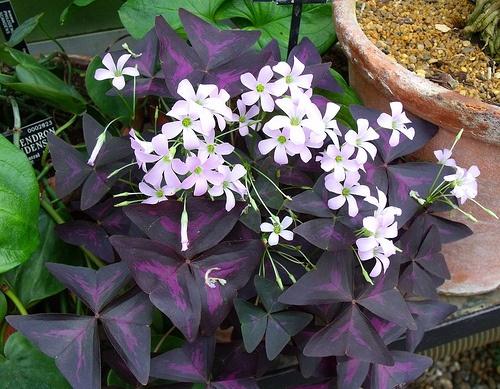
Oxalis is a flowering perennial herbaceous plant. There is quite many types of sorrel (about 800). Among the representatives of the genus there are herbaceous plants, bushes and subshrubs.One of the beautiful and delicate varieties is purple sorrel, which from the beginning of spring to the end of autumn can delight with its exquisite flowering.
Oxalis blooms a month after planting. Its small, inconspicuous flowers, painted purple, pink or white, form an umbrella inflorescence that looks beautiful against the background of purple leaves.
Spreading
The homeland of wood sorrel is tropical and subtropical regions of all continents. It is found wild in South America, Africa and Southern Europe. In our country it is grown as a houseplant.
The unique property of oxalis
Purple oxalis has one characteristic feature: it triangular leaves fold up and lower in cloudy weather or after dark. At this time, it seems that a flock of butterflies is located on the plant. That's why they call the sorrel Madame Butterfly or butterfly flower. Once the plant senses enough light, the petals return to their original position.
Oxalis care: temperature and lighting
Caring for purple sorrel involves ensuring light and temperature conditions. Oxalis loves sunny places, but also grows in partial shade. For long-term flowering, it is best to choose a cool, illuminated place. With a lack of sunlight, the leaves may lose their decorative effect and decrease in size, and the stems may become elongated. In hot conditions, the quality of purple sorrel flowering decreases and burns appear on the leaves. Therefore, it needs to be shaded from bright rays.
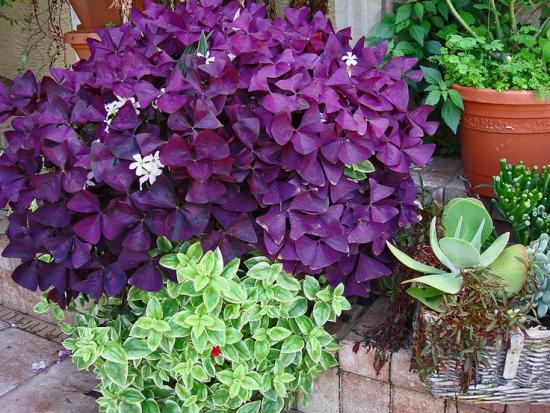
In the spring-summer period, it is desirable to maintain the temperature at 20-25 degrees C, in the autumn-winter period - 10-18 degrees C.
Oxalis care: watering
During the flowering period, the plant needs frequent watering, as well as spraying the leaves with water. It is best to use distilled water.
Top dressing
From April to September, oxalis is fed once every 2-3 weeks. To do this, use a weak solution of complex mineral fertilizer: its concentration should be 2 times less than specified in the instructions.
Caring for the plant during the dormant period
Oxalis care purple application should be carried out not only during flowering, but also in winter, when the plant is resting.
In winter, you should choose a cool place for the flower, but the air temperature in the room should not be lower than ten degrees. At this time, purple sorrel should be watered as rarely as possible, as needed. Spraying leaves with water should be completely avoided.
As soon as the plant has young shoots, it is recommended to move it to its original place that satisfies the flowering conditions.
Landing
Young plants require annual replanting in loose soil, older ones can be replanted once every 2-3 years.
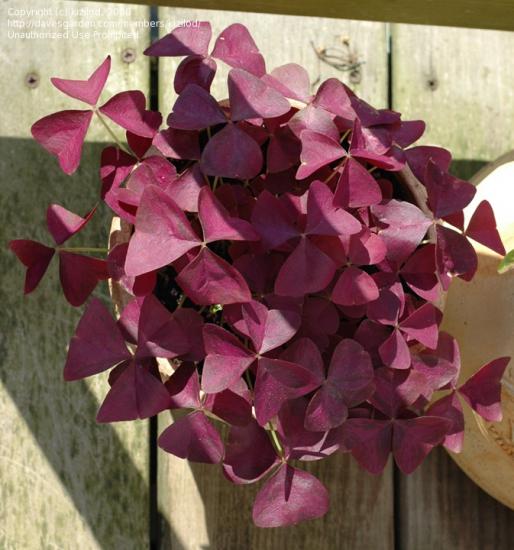
For planting, take leaf, humus, peat soil and sand in a ratio of 1:1:3:1. If desired, you can use ready-made soil for indoor flowers. Expanded clay or pebbles are placed at the bottom of the pot to prevent water from stagnating.
To make the flower look more decorative, several plants are placed in one pot.
After planting, you need to periodically loosen the soil in the pot.
Reproduction
Purple oxalis reproduces by small nodules that form on the old root system of the plant. The nodules (5-10 pieces) are placed in a pot and covered with a centimeter layer of soil.
Pests and diseases
Pests and diseases rarely appear on sorrel.Sometimes it is affected by aphids, mites, scale insects, whiteflies, red mites and scale insects. To get rid of them, use appropriate insecticidal preparations.
Excessive watering can cause rotting of the underground part of the plant, the appearance of gray rot or fusarium.
Give this unpretentious flower a little attention, and it will bring you joy for a long time.


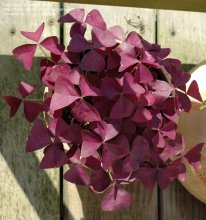

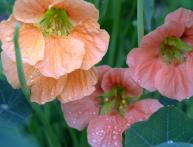





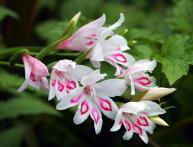
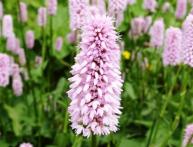
Comments
I didn’t even know that you could plant this plant on your windowsill! This is such a good idea. This species, purple sorrel, looks so interesting - triangular leaves with a purple tint, great! Now I really want to plant it at home, it doesn’t seem to be very difficult to care for! All that remains is to find the seeds, I hope you can find them on sale!
My wood sorrel also grew, but for some reason it died after a while: the leaves began to turn pale and dry out. No pests were found; most likely, she was too hot on the balcony in the summer. In general, I liked the plant because of the intense purple color of the leaves; it looked great next to the greenery of other plants.
Hi all. There is a problem. My flower is dying. It's winter now, but quite warm. My flower has moved from another place. I don’t keep it on window sills because it is small, but there were a lot of flowers (leaves), I tried to provide maximum lighting. The flowers are rotting. I don’t understand what’s wrong with her. Help me please. The flower is very expensive.